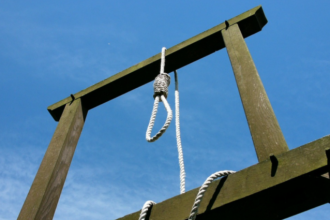Ambrose Bierce
A man stood upon a railroad bridge in northern Alabama, looking down into the swift water twenty feet below. The man’s hands were behind his back, the wrists bound with a cord. A rope closely encircled his neck. It was attached to a stout cross-timber above his head and the slack fell to the level of his knees. Some loose boards laid upon the sleepers supporting the metals of the railway supplied a footing for him and his executioners—two private soldiers of the Federal army, directed by a sergeant who in civil life may have been a deputy sheriff. At a short remove upon the same temporary platform was an officer in the uniform of his rank, armed. He was a captain. A sentinel at each end of the bridge stood with his rifle in the position known as “support,” that is to say, vertical in front of the left shoulder, the hammer resting on the forearm thrown straight across the chest—a formal and unnatural position, enforcing an erect carriage of the body. It did not appear to be the duty of these two men to know what was occurring at the centre of the bridge; they merely blockaded the two ends of the foot planking that traversed it.
Beyond one of the sentinels nobody was in sight; the railroad ran straight away into a forest for a hundred yards, then, curving, was lost to view. Doubtless there was an outpost farther along. The other bank of the stream was open ground—a gentle acclivity topped with a stockade of vertical tree trunks, loop-holed for rifles, with a single embrasure through which protruded the muzzle of a brass cannon commanding the bridge. Midway of the slope between bridge and fort were the spectators—a single company of infantry in line, at “parade rest,” the butts of the rifles on the ground, » Read More
https://theimaginativeconservative.org/2024/11/occurrence-owl-creek-bridge-ambrose-bierce.html
Have an existing account?
Sign In
© 2024 Paperless Times






